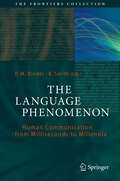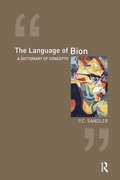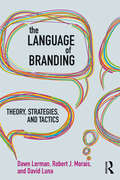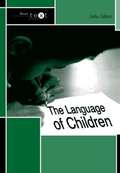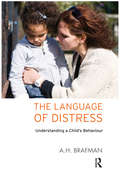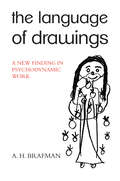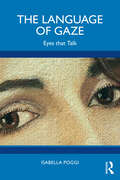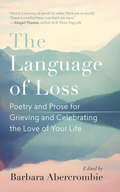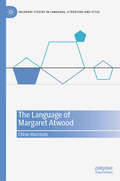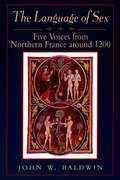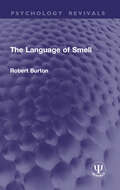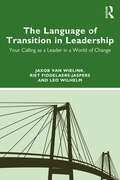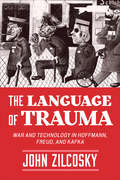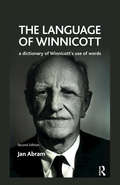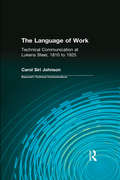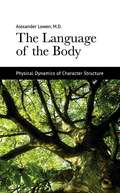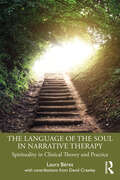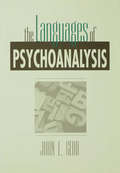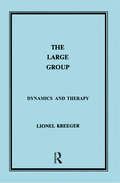- Table View
- List View
The Language Phenomenon
by K. Smith P. M. BinderThis volume contains a contemporary, integrated description of the processes of language. These range from fast scales (fractions of a second) to slow ones (over a million years). The contributors, all experts in their fields, address language in the brain, production of sentences and dialogues, language learning, transmission and evolutionary processes that happen over centuries or millenia, the relation between language and genes, the origins of language, self-organization, and language competition and death. The book as a whole will help to show how processes at different scales affect each other, thus presenting language as a dynamic, complex and profoundly human phenomenon.
The Language and Thought of the Child: Selected Works Vol 5 (Routledge Classics Ser.)
by Jean PiagetExplore the fascinating world of childhood cognition with Jean Piaget's groundbreaking work, "The Language and Thought of the Child." This seminal book provides an in-depth analysis of how children develop language and thought, offering profound insights into the cognitive processes that shape their understanding of the world.Jean Piaget, a renowned Swiss psychologist, revolutionized our understanding of child development through his meticulous observations and innovative research. In "The Language and Thought of the Child," Piaget delves into the intricacies of children's language acquisition and cognitive development, presenting his findings with clarity and rigor.The book examines the stages of language development, from the early use of gestures and simple words to the complex structures of sentences and logical reasoning. Piaget explores how children use language to express their thoughts, interact with their environment, and solve problems. He identifies key patterns and stages in their cognitive growth, highlighting the transition from egocentric speech to socialized communication.Through detailed case studies and observational data, Piaget reveals the ways in which children’s thinking evolves in tandem with their linguistic abilities. He discusses concepts such as animism, artificialism, and moral reasoning, providing a comprehensive overview of the cognitive milestones that characterize early childhood."The Language and Thought of the Child" is not just a theoretical text but also a practical guide for parents, educators, and psychologists. Piaget’s insights offer valuable guidance on how to support and nurture children's intellectual and linguistic development, emphasizing the importance of interactive learning and constructive play.This book remains a cornerstone in the field of developmental psychology, celebrated for its depth of analysis and enduring relevance. Jean Piaget’s work continues to inspire and inform those who study the complex interplay between language and thought in children. Whether you are a student of psychology, an educator, or a parent, "The Language and Thought of the Child" provides essential knowledge and inspiration for understanding and fostering the intellectual growth of young minds.
The Language of Bion: A Dictionary of Concepts
by P.C. SandlerConsidering that introductory books cannot replace an author's original words,and that Bion’ s concepts are often found to be difficult to grasp, Dr Sandler has compiled an unusual style of dictionary. He assembles. He assembles relevant quotations from Bion's texts together with the meaning of concepts and their place in the history of their development.
The Language of Branding: Theory, Strategies, and Tactics
by Dawn Lerman Robert J. Morais David LunaThe Language of Branding: Theory, Strategies and Tactics shows marketers how to use language successfully to improve brand value and influence consumer behavior. Luna and Lerman are among only a few researchers who take a multidisciplinary perspective on the ways language influences how consumers act. Together with Morais, an anthropologist engaged in market research, they show how understanding the power of language can impact the essence – and sales – of a brand. The book covers the fundamentals of brand language and applications for an array of marketing initiatives. Readers will learn why brand language matters, how language is used in marketing, and how to build a brand strategy that capitalizes on the richness and complexity of language. This book includes real-world case histories that demonstrate vividly how brand language is created and exercises that enable both students of marketing and marketing professionals to apply the book’s concepts and stimulate class discussion. The Language of Branding: Theory, Strategies and Tactics can be used in a number of courses, including consumer behavior, branding, advertising, linguistics, and communications.
The Language of Children
by Julia GillenThe Intertext series has been specifically designed to meet the needs of contemporary English language studies. Working with Texts: A Core Introduction to Language Analysis (second edition, 2001) is the foundation text, which is complemented by a range of satellite titles. These provide students with hands-on practical experience of textual analysis through special topics and can be used individually or in conjunction with Working with Texts.
The Language of Choice Theory
by William GlasserIn this companion volume to the bestselling Choice Theory, Dr. William Glasser and his wife, Carleen Glasser, have imagined typical conversations in real-life situations--between parent and child, two partners in a relationship, teacher and student, and boss and employee. On the left-hand page is a typical controlling order or threat, and on the right a more reasonable version, using choice theory, which is more likely to get a favorable response from the child, lover, student, or employee. Through these examples, the principles of choice theory come alive.
The Language of Choice Theory
by William GlasserIn this companion volume to the bestselling Choice Theory, Dr. William Glasser and his wife, Carleen Glasser, have imagined typical conversations in real-life situations--between parent and child, two partners in a relationship, teacher and student, and boss and employee. On the left-hand page is a typical controlling order or threat, and on the right a more reasonable version, using choice theory, which is more likely to get a favorable response from the child, lover, student, or employee. Through these examples, the principles of choice theory come alive.
The Language of Distress: Understanding a Child's Behaviour
by A.H. BrafmanThis book describes a series of cases where the child's presenting complaint is seen to be the expression of an underlying emotional conflict that the child expects the parents to understand and help him or her to overcome. The parents' interpretation of the child's symptoms cannot but be influenced by their own previous life experiences and if their eventual response does not meet the child's anxiety, the child feels misunderstood and the physical complaint remains unchanged. When seeing child and parents in a consultation, an attempt is made to discover the unconscious fantasy that underlies the presenting physical complaint, and also to investigate what led the parents to approach their child in the particular manner that, in practice, perpetuated the symptom. The proposal is put forward that the symptom can be seen as a language, a manner of expressing an underlying emotional anxiety. Once the therapist formulates this message in words the child can understand, and helps the parents to understand their response to the child, it becomes possible for the parents to approach the child in a more effective manner - and the symptom disappears.
The Language of Drawings: A New Finding in Psychodynamic Work
by A.H. BrafmanIf a person is struggling with feeling that involve pain or anxiety, then we find a complex network of difficulties affecting that person's capacity to express what torments him. Whatever the person's age, they very often have no access to the words that might convey their internal conflicts. People interacting with that person may believe he is deliberately refusing to express what affects him, but it is certainly true that most times this is not the case. When dealing with children, these difficulties are even more acute. However, children often express in their drawings elements of the conflicts they are experiencing in themselves and the world in which they live. The author applied these findings in his work - not only with children and adolescents, but at times also with adults.This fascinating book arose from the discovery that single drawings could at times represent only a part of an underlying emotional experience that "completed" its expression in another picture drawn after that first one.
The Language of Gaze: Eyes that Talk
by Isabella PoggiVerbal and nonverbal communicative acts mark the links within our discourse, help us to exchange turns and give backchannel in conversation. This book analyses the communicative system of gaze in depth, investigating its structure and functions the same way that words and gestures are studied, and shows how to do so by establishing a phonology, a morphology and a semantics of eye communication, before finally outlining a lexicon of gaze.Poggi provides a detailed semantic analysis of lexical items, highlights the role of gaze in multimodal communication, and illustrates its uses in everyday life, politics, education and musical performance. The meanings we communicate by gaze are intertwined with the multimodality of our communication, thus integrating, complementing, sometimes contradicting, whether deliberately or inadvertently, what we say with words or gestures.Starting from a robust theoretical framework, this book also provides an overview of the methods that can be exploited to study gaze, ranging from ethno-semantics to observation and simulation, and provides examples of their use.A timely and original contribution that is essential reading for advanced students, scholars and researchers of multimodal communication, pragmatics, social psychology and related areas.
The Language of Loss: Poetry and Prose for Grieving and Celebrating the Love of Your Life
by Barbara AbercrombieWhen Barbara Abercrombie&’s husband died, she found the language of condolence irritating, no matter how well intended. &“My husband had not gone to a better place as if he were off on a holiday. He had not passed like clouds overhead, nor was he my late husband as if he&’d missed a train. I had not lost him as if I&’d been careless, and for sure, none of it was for the best.&” She yearned instead for words that acknowledged the reality of death, spoke about the sorrow and loneliness (and perhaps even guilt and anger), and might even point the way toward hope and healing. She found those words in the writings gathered here. The Language of Loss is a book to dip into and read slowly, a collection of poems and prose to lead you through the phases of grief. The selections follow an arc that mirrors the path of many mourners — from abject loss and feeling unmoored, to glimmers of promise and possibility, through to gratitude for the love they knew. These writings, which express what often feels ineffable, will accompany those who grieve, offering understanding and solace.
The Language of Margaret Atwood (Palgrave Studies in Language, Literature and Style)
by Chloe HarrisonThis book explores Margaret Atwood’s distinctive use of language and style, across a selection of her prose texts, through reader-centred, cognitive stylistic analyses. It examines how strategies of misdirection, processes of doubling, and the creation of textual ambience play an essential role in Atwood’s contemporary prose fiction style. With reference to contemporary scholarship in stylistics and literary criticism, each chapter presents a detailed linguistic analysis of a different text from Atwood’s oeuvre, from Alias Grace (1996) to Old Babes in the Wood (2023). Above all, the book studies experiences of reading Atwood’s works, situating and contextualising her signature linguistic choices in relation to real readers’ responses to her writing. The book should be of interest to readers specialising in the work of Margaret Atwood, including those with stylistics, cognitive linguistics, and literary studies backgrounds.
The Language of Psychoanalysis (The\international Psycho-analytical Library #No. 94)
by Jean Laplanche Jean-Bertrand PontalisSigmund Freud evolved his theories throughout his lifetime. This entailed many revisions and changes which he himself never tried to standardise rigidly into a definitive conceptual system. The need for some sort of a reliable guide which would spell out both the pattern of the evolution of Freud’s thinking, as well as establish its inherent logic, was felt for a long time by both scholars and students of psychoanalysis. Drs Laplanche and Pontalis of the Association Psychanalytique de France succeeded admirably in providing a dictionary of Freud’s concepts which is more than a compilation of mere definitions. After many years of creative and industrious research, they were able to give an authentic account of the evolution of each concept with pertinent supporting texts from Freud’s own writing (in the Standard Edition translation), and thus have endowed us with an instrument for work and research which is characterised by its thoroughness, exactitude and lack of prejudice towards dogma. The Language of Psychoanalysis is an established classic that will long continue to be of invaluable use to both the student and the research-worker in psychoanalysis.
The Language of Service Encounters: A Pragmatic-Discursive Approach
by J. César Félix-BrasdeferService encounters are ubiquitous in social interaction. We buy food and everyday items in supermarkets, convenience stores, or markets; we purchase merchandise in department stores; or we request information at a visitor information center. This book offers a comprehensive account of service encounters in commercial and non-commercial settings. Grounded in naturally occurring face-to-face interactions and drawing on a pragmatic-discursive approach, J. César Félix-Brasdefer sets out a framework for the analysis of transactional and relational talk in various contexts in the United States and Mexico. This book investigates cross-cultural and intra-lingual pragmatic variation during the negotiation of service. The author provides a broad review of research on service encounters to date, and analyzes characteristics of sales transactions, such as participants' roles, pragmatic and discourse functions of relational talk and address forms, the realization of politeness, and changes in alignment from transactional to relational talk. Examines face-to-face interactions in commercial and non-commercial service encounter settings, including the analysis of transactional and non-transactional talk. Analyzes pragmatic and sociolinguistic variation, including linguistic, regional, intra-lingual, and gender variation. Reviews and evaluates methods and techniques for the collection and analysis of corpus data in service encounters in naturalistic settings.
The Language of Sex: Five Voices from Northern France around 1200
by John W. BaldwinThis study brings together widely divergent discourses to fashion a comprehensive picture of sexual language and attitudes at a particular time and place in the medieval world. John Baldwin introduces five representative voices from the turn of the twelfth century in northern France: Pierre the Chanter speaks for the theological doctrine of Augustine; the Prose Salernitan Questions, for the medical theories of Galen; Andre the Chaplain, for the Ovidian literature of the schools; Jean Renart, for the contemporary romances; and Jean Bodel, for the emerging voices of the fabliaux. Baldwin juxtaposes their views on a range of essential subjects, including social position, the sexual body, desire and act, and procreation. The result is a fascinating dialogue of how they agreed or disagreed with, ignored, imitated, or responded to each other at a critical moment in the development of European ideas about sexual desire, fulfillment, morality, and gender. These spokesmen allow us into the discussion of sexuality inside the church and schools of the clergy, in high and popular culture of the leity. This heterogeneous discussion also offers a startling glimpse into the construction of gender specific to this moment, when men and women enjoyed equal status in sexual matters, if nowhere else. Taken together, these voices extend their reach, encompass their subject, and point to a center where social reality lies. By articulating reality at its varied depths, this study takes its place alongside groundbreaking works by James Brundage, John Boswell, and Leah Otis in extending our understanding of sexuality and sexual behavior in the Middle Ages. "Superb work. . . . These five kinds of discourse are not often treated together in scholarly writing, let alone compared and contrasted so well. "—Edward Collins Vacek, Theological Studies "[Baldwin] has made the five voices speak to us in a language that is at one and the same time familiar and alien in its resonance and accents. This is a truly exceptional book, interdisciplinary in the real sense of the word, which is surely destined to become a landmark in medieval studies. "—Keith Busby, Bryn Mawr Reviews "[Baldwin's] attempt to 'listen' to these distant voices and translate their language of sex into our own raises challenging methodological questions that will be of great interest to historians and literary scholars alike. "—John P. Dalton, Comitatus
The Language of Smell (Psychology Revivals)
by Robert BurtonThe sense of smell is at least equally important to may animals as sight and hearing. This important fact had previously been largely overlooked and is the subject of this fascinating study of the animal kingdom, The Language of Smell, originally published in 1976.Robert Burton, a zoologist and writer on wildlife, surveys the use of the sense of smell, from ants and butterflies, through birds, to whales and other mammals, and to human beings themselves. He describes the organs of smell and discusses the theories as to the way that odours are converted into nerve impulses. He considers the recent scientific advances in the field, including the observations on wild animals and laboratory experiments which show how smell is used for finding food, repelling enemies and for navigation. Many animals also use smell for communication. They produce special odours, called pheromones, that act as signals to members of their own species. Robert Burton shows how pheromones play a particularly important part in the social and sexual lives of insects and mammals, and that human beings also make more use of their sense of smell than had been thought.Throughout the book illustrations and line drawings are used to clarify the descriptions of the vital and exciting ‘language of smell’.
The Language of Transition in Leadership: Your Calling as a Leader in a World of Change
by Jakob van Wielink Leo Wilhelm Riet Fiddelaers-JaspersIn this book, the authors utilise their decades of experience in leadership and coaching for change to help leaders develop the necessary skills to lead people and organisations in transition. Combining a scientific and practice-based approach, they show readers how to develop and maintain their own impactful leadership style while creating psychological safety in their teams. Leadership that achieves sustainable results comes from connecting past, present and future. Describing leadership as a journey, the book invites the reader to discover their calling and realise the importance of examining the roots of their leadership, before thinking about its destination. It gives leaders access to a new dimension of unprecedented growth and demonstrates the ways these lessons and skills can transform change into lasting transitions. Accessible and written in a lively style, The Language of Transition in Leadership is an important book for leaders and executives. It will also be of interest to coaches, organisational advisors, management consultants, students of leadership and those transitioning into the workforce.
The Language of Trauma: War and Technology in Hoffmann, Freud, and Kafka
by John ZilcoskyFrom the Napoleonic Wars to the invention of the railway to the shell shock of World War I, writers tried to give voice to the suffering that war and industrial technology had wrought all around them. Yet they, like the doctors who treated these victims, repeatedly ran up against the incapacity of language to describe such anguish; those who suffered trauma, those who tried to heal it, and those who represented it were all unable to find the appropriate words. In The Language of Trauma, John Zilcosky uncovers the reactions of three major central European writers – E.T.A. Hoffmann, Sigmund Freud, and Franz Kafka – to the birth of modern trauma in the nineteenth and early twentieth centuries. Zilcosky makes the case that Hoffmann, Freud, and Kafka managed to find the language of trauma precisely by not attempting to name the trauma conclusively and instead allowing their writing to mimic the experience itself. Just as the victims’ symptoms seemed not to correspond to a physical cause, the writers’ words did not connect directly to the objects of the world. While doctors attempted to overcome this indeterminacy, these writers embraced and investigated it; they sought a language that described language’s tragic limits and that, in so doing, exemplified the wider literary and philosophical crisis of their time. Zilcosky boldly argues that this linguistic scepticism emerged together with the medical inability to name the experience of trauma. He thereby places trauma where it belongs: at the heart of both medicine’s diagnostic predicament and modern literature’s most daring experiments.
The Language of Winnicott: A Dictionary of Winnicott's Use of Words
by Jan AbramThe author's lexicon - The Language of Winnicott - has proved to be the definitive comprehensive guide to Winnicott's thought since it was first published in 1996, Winnicott's centenary Year. The twenty-two entries represent the major conceptualisations in Winnicott's theories and take the reader on a journey through his writings that span from 1931 to 1971. Thus the volume is an anthology of Winnicott's writings. This new edition expands on each original entry predicated on the author's research discoveries, including archival material, over the past decade.
The Language of Work: Technical Communication at Lukens Steel, 1810 to 1925 (Baywood's Technical Communications)
by Charles H. Sides Carol Siri JohnsonLukens Steel was an extraordinary business that spanned two centuries of American history. The firm rolled the first boiler plate in 1818 and operated the largest rolling mills in America in 1890, 1903, and 1918, Later it worked on the Manhattan Project and built the steel beams for the base of the World Trade Center. The company stayed in the family for 188 years, and they kept the majority of their business papers."The Language of Work" traces the evolution of written forms of communication at Lukens Steel from 1810 to 1925. As standards for iron and steel emerged and industrial processes became more complex, foremen, mechanics, and managers began to use drawing and writing to solve problems, transfer ideas, and develop new technology. This shift in communication methods - from 'prediscursive' (oral) communication to 'chirographic' (written) communication - occurred as technology became more complex and knowledge had to span space and time.This richly illustrated volume begins with a theoretical overview linking technical communication to literature and describing the historical context. The analysis is separated into four time periods: 1810 to 1870, when little writing was used; 1870-1900, when Lukens Steel began to use record keeping to track product from furnace, through production, to the shipping dock; 1900-1915, when written and drawn communication spread throughout the plant and literacy became more common on the factory floor; and 1915-1925, when stenographer typists took over the majority of the written work. Over time, writing - and literacy - became an essential part of the industrial process.
The Language of the Body: Physical Dynamics of Character Structure
by Alexander LowenThe Language of the Body, originally published as Physical Dynamics of Character Structure, brilliantly describes how personality is expressed in the form and function of the body. The body is the key to understanding behavior and working with the body is the key to psychological health. The Language of the Body outlines the foundations of character structure: schizoid, oral, masochistic, hysteric, and phallic narcissistic personality types. Dr. Lowen examines the relationship between psychoanalytic theory and body therapy.
The Language of the Soul in Narrative Therapy: Spirituality in Clinical Theory and Practice
by Laura BéresThe Language of the Soul in Narrative Therapy uniquely bridges the gap between narrative therapy and spirituality to describe how the theory and practice of narrative therapy may be expanded and enriched by incorporating the language of the soul. Divided into three parts, the book begins by contextualizing the approach of narrative therapy and spirituality. Chapters then debate the complexity of the ‘soul’ as a term drawing on the work of Christian mystics and philosophers, such as Teresa of Avila, Edith Stein, Merleau-Ponty, and Bakhtin, to show how their theoretical ideas can be incorporated in counseling practice and spiritual direction. The book concludes by discussing how the language of the soul can be integrated and applied in postmodern practice. With case examples from faith belief systems, such as Christianity, Buddhism, Paganism, Wicca, and Yazidism, throughout, this book is essential reading for therapists, clinical social workers, and counsellors in practice and graduate training, as well as spiritual directors and pastoral counselors interested in the ideas and practices of narrative therapy.
The Languages of Psychoanalysis
by John E. GedoIn this remarkable survey of "the communicative repertory of humans," John Gedo demonstrates the central importance to theory and therapeutics of the communication of information. He begins by surveying those modes of communication encountered in psychoanalysis that go beyond the lexical meaning of verbal dialogue, including "the music of speech," various protolinguistic phenomena, and the language of the body. Then, turning to the analytic dialogue, Gedo explores the implications of these alternative modes of communication for psychoanalytic technique. Individual chapters focus, in turn, on the creation of a "shared language" between analyst and analysand, the consequences of the analytic setting, the form in which the analyst casts particular interventions, the curative limits of empathy, the analyst's affectivity and its communication to the patient, and the semiotic significance of countertransference and projective identification. Gedo does not proffer semiotics as a substitute for metapsychology. He is explicit that communicative skill is always dependdent on somatic events within the central nervous system. Indeed, it is because Gedo's hierarchical approach to communication builds on our current understanding of a hierarchically organized central nervous system that his clincal observations become insights into basic psychobiological functioning. Grounded in Gedo's four decades of clinical experience, The Languages of Psychoanalysis points to a new venue of clinical research and conceptualization, one in which attentiveness to issues of communication will not only foster linkages with contemporary neuroscience, but also clarify and enlarge the therapeutic possibilities of psychoanalytic treatment.
The Large Dam Dilemma
by Pu Wang Shikui Dong James P. LassoieLarge dam construction has significant environmental and social impacts at different scales. As the largest developing country in the world, China has built about half of the world's large dams, and more are expected to be built over the next two decades to meet the country's rapidly growing demand for energy. This book summarizes and updates information about the history, distribution, functions, and impacts of large dams, both globally and at China's national level. It then addresses the environmental and social-economic impacts of large dams in China with particular emphasis on the impacts of large dams on relocated people and associated compensation policies. Lastly, it introduces an integrated ecological and socio-economic study conducted in areas affected by dams along the Upper Mekong River, China. This book has the following three goals. The first goal is to summarize and update information on large dams globally and at China's national level (Ch. 2). We examine large dam problems from different perspectives, ranging from their spatial and temporal distributions and their environmental and social impacts, to discussions and debates centered on them. We also incorporate the results of an empirical investigation of the environmental and socio-economic impacts of large dams on the Upper Mekong River, China, and draw conclusions out of the analysis (Chs. 3 & 4). Our second goal is to provide an analysis framework to help understand the environmental and social-economic impacts of dam construction and the resulting environmental degradations and social inequities at different scales (Chs. 3 & 4), as well as to offer recommendations for mitigating these impacts within China's socio-political context (Ch. 5). The significant environmental effects resulting from dam construction include damage to ecological integrity and loss of biological diversity. The most significant social consequences brought by dam projects are their negative impacts on relocated people. Our analysis framework provides approaches to help comprehensively understand these impacts. Our third goal is to provide clues and suggestions for further studies of large dam problems both globally and in China (Ch. 5). The construction of large dams is proceeding rapidly in different parts of the world despite the heated debates on whether they should be built at all. The decision-making process related to building large dams involves considerations of economic viability, environmental sustainability, and social equity. Therefore, interdisciplinary collaborations are required in large dam research and development projects in order to reconcile the interests of different stakeholders and avoid harming ecosystems, biodiversity, and human welfare. Overall, we hope our book facilitates future examinations of large dams by providing summaries of existing data and research related to large dams, and offering a framework for better understanding and analyzing their environmental and social impacts.
The Large Group: Dynamics and Therapy
by Lionel KreegerThis important, pioneering book collates our knowledge of large groups, both at a theoretical and practical level. Thirteen distinguished contributors offer experiences from a wide range of disciplines and settings. Roughly half the chapters are psychoanalytic in their orientation; other contributions derive from general psychiatry, sociology, anthropology and industrial psychology.The place of large-group therapy is still to be defined, but it is hoped that this book will contribute to the careful and detailed assessment that is necessary to fulfill its evaluation.
